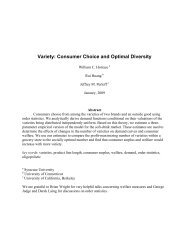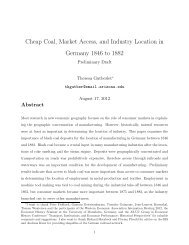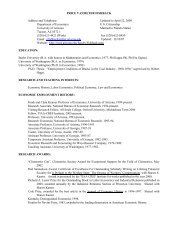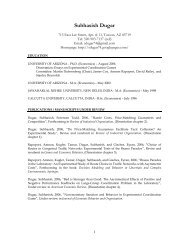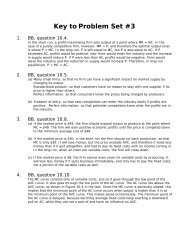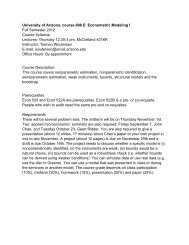A Dynamic Model of Demand for Houses and Neighborhoods
A Dynamic Model of Demand for Houses and Neighborhoods
A Dynamic Model of Demand for Houses and Neighborhoods
You also want an ePaper? Increase the reach of your titles
YUMPU automatically turns print PDFs into web optimized ePapers that Google loves.
In theory, we could estimate the θ transition probabilities separately by type, as we have a<br />
time series <strong>for</strong> each type <strong>and</strong> neighborhood. However, to increase the efficiency <strong>of</strong> our estimates,<br />
we impose some restrictions. For example, within each type we could assume that the neigh-<br />
borhood mean utilities, θτ jt , evolve according to an auto-regressive process where some <strong>of</strong> the<br />
coefficients are common across neighborhoods. In practice, we estimate transition probabilities<br />
separately <strong>for</strong> each type but pool in<strong>for</strong>mation over neighborhoods. To account <strong>for</strong> different means<br />
<strong>and</strong> trends we include a separate constant <strong>and</strong> time trend <strong>for</strong> each neighborhood’s choice specific<br />
value function <strong>for</strong> each type. We model the transition <strong>of</strong> the choice specific value functions, θ τ jt ,<br />
as:<br />
θ τ jt = ρ τ 0,j +<br />
L�<br />
l=1<br />
ρ τ 1,l θτ jt−l +<br />
L�<br />
l=1<br />
Xjt−l′ρ τ 2,l + ρτ 3,j t + ω τ jt<br />
where the time varying neighborhood attributes included in Xjt are price, racial composition<br />
(percentage white), pollution (number <strong>of</strong> days ozone concentration exceed the Cali<strong>for</strong>nia state<br />
maximum threshold), <strong>and</strong> the violent crime rate. 16<br />
We also need to know how housing wealth transitions in order to specify transition probabili-<br />
ties <strong>for</strong> types. We use sales data to construct price indexes <strong>for</strong> each type, tract, year combination.<br />
Recalling that price is one <strong>of</strong> the variables in X, we estimate transition probabilities on price<br />
levels according to:<br />
pricejt = ϱ0,j +<br />
L�<br />
l=1<br />
Xjt−l′ϱ2,l + ϱ3,j t + ϖ τ jt<br />
Given transition probabilities on price levels it is straight<strong>for</strong>ward to estimate transition prob-<br />
abilities <strong>for</strong> wealth <strong>and</strong> type, τ. In both cases, we use two lags <strong>of</strong> the dependent variable (θ τ jt or<br />
priceτ jt ) as well as two lags <strong>of</strong> the other exogenous variables in X.<br />
Knowing θ, P MC, <strong>and</strong> the transition probabilities allows us to calculate mean flow utilities<br />
<strong>for</strong> each type <strong>and</strong> neighborhood, δτ jt , according to:<br />
δ τ jt = θ τ �<br />
jt − βE log<br />
� J �<br />
k=0<br />
exp(θ τt+1<br />
kt+1 − MCτt+1<br />
jt+1I �� �<br />
��sit,<br />
[k�=j]) di,t = j<br />
where in practice, s includes all the variables on the right h<strong>and</strong> side <strong>of</strong> equations (16) <strong>and</strong> (17)<br />
16 For the outside option, we don’t observe any attributes <strong>and</strong> we estimate with only lags <strong>of</strong> the choice specific<br />
value function. That is, we estimate θ τ 0t = ρ τ 0,0 + � L<br />
l=1 ρτ 1,lθ τ 0t−l + ρ τ 3,0 t + v τ 0t<br />
24<br />
(16)<br />
(17)<br />
(18)



